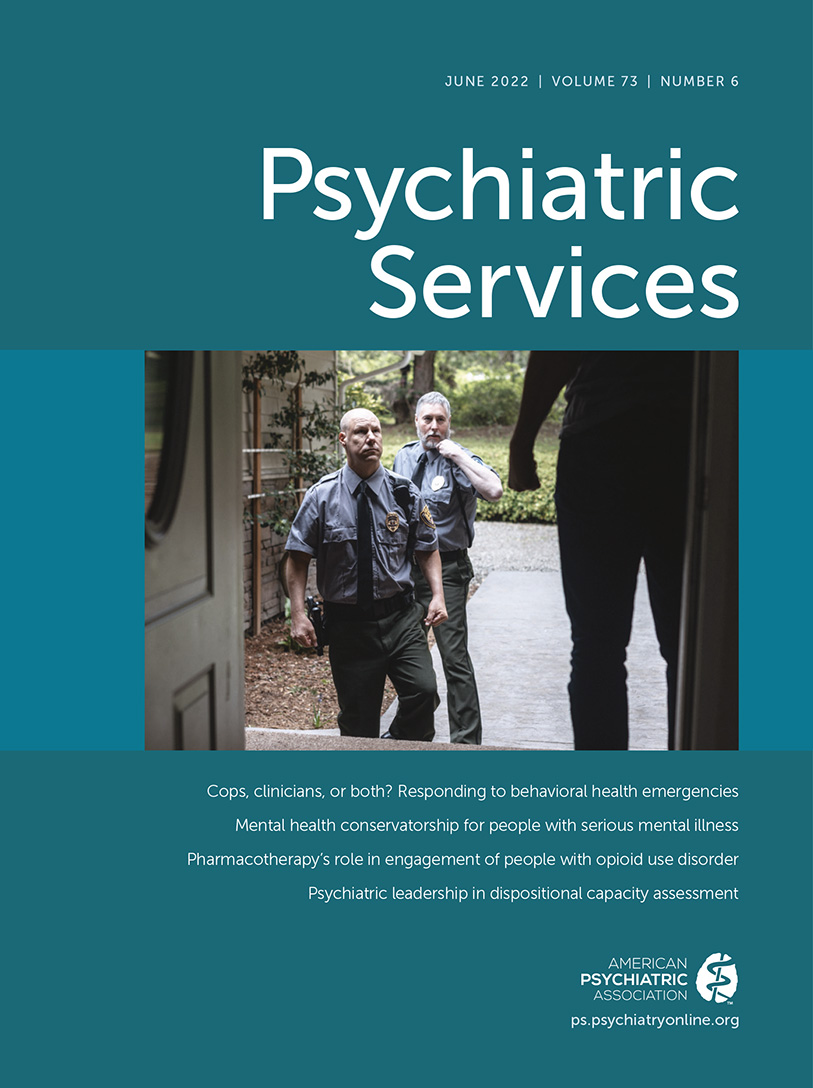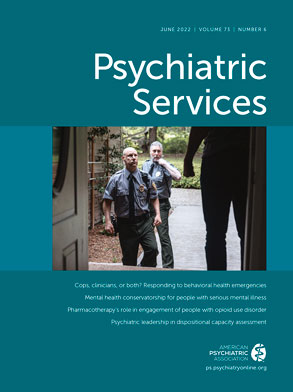Pediatric mental health problems are common, with an estimated 17% of children having at least one psychiatric disorder (
1). Recent data suggest that the COVID-19 pandemic has significantly worsened children’s mental health. A national survey showed that 14% of families reported that their children’s mental health worsened during the COVID-19 pandemic (
2). A sharp increase in pediatric emergency department visits for mental health concerns was also recorded, beginning in mid-March 2020 (
3).
The increased need for pediatric mental health care due to COVID-19 compounds pressure on an already strained system in which the gap between the need for and availability of mental health services is well known (
1,
4). Before the COVID-19 pandemic, it was estimated that nearly half of youths with a psychiatric diagnosis were not receiving treatment (
1). A significant barrier to care access is the limited number of specialty mental health providers (e.g., child psychiatrists) (
1). Although the number of child psychiatrists has recently grown, 70% of counties across the United States remain without access to a child psychiatrist (
5).
Bolstering the knowledge and skills of pediatric primary care providers (PCPs) in managing common pediatric mental health problems has been identified as one way to address the services gap; this endeavor may be even more critical during the pandemic, when mental health concerns are on the rise (
6). Pediatric Mental Health Care Access (PMHCA) programs, also called Child Psychiatry Access programs, were established to increase PCPs’ capacity to manage pediatric mental health problems by providing continuing education, clinical consultation, and resource-referral support; in addition, some programs also offer limited direct-to-patient consultation and treatment (e.g., telepsychiatry evaluation) (
7).
These programs, now operating in >30 states, have shown positive effects on mental health outcomes; these benefits include decreases in antipsychotic prescriptions, increased provider capacity for addressing mental health concerns, and increased identification and connection to mental health supports (
8–
10). The purpose of this brief report is to describe trends in PCP calls to two PMHCA programs (representing diverse geographic areas, health care systems, populations, and program maturity) before and during the COVID-19 pandemic.
Methods
Behavioral Health Integration in Pediatric Primary Care (BHIPP), a PMHCA program established in October 2012, provides free training, resource-referral networking, and clinical consultation to pediatric PCPs across Maryland. Child Access to Mental Health and Psychiatry (CHAMP), a PMHCA program established in 2018, provides free clinical consultation, resource-referral networking, and training to pediatric PCPs across Mississippi. CHAMP’s phone consultation line launched in late August 2019. Both BHIPP and CHAMP provide a “warmline” staffed by master’s-level behavioral health clinicians who answer general behavioral health questions and collect patient information from PCPs seeking consultation or community-based resources for their patients. When clinical consultation is requested, calls are triaged to a child and adolescent psychiatrist (BHIPP and CHAMP) or clinical psychologist (CHAMP).
The BHIPP sample for this study included 2,576 phone contacts with PCPs between January 2019 and March 2021. The CHAMP sample included 264 phone contacts with PCPs between September 2019 and March 2021. Institutional review board approval was obtained from Johns Hopkins University, the University of Maryland, and the Maryland Department of Health for BHIPP and from the University of Mississippi Medical Center for CHAMP.
Both programs collect the following patient information during phone contacts with PCPs: reason for call (e.g., clinical consultation, resource-referral networking), patient demographic characteristics, as well as the PCP’s primary mental health concern during the call (e.g., anxiety, behavior problems) and working diagnoses for the patient. On the basis of discussion with the PCP, the consulting mental health specialist records their own diagnostic impressions of the patient, rates the clinical severity of the patient using the Clinical Global Impressions (CGI) score (a one-item measure capturing clinical impressions of patient severity on a seven-point scale ranging from “normal” to “extremely ill”), and records data about the next steps that they recommended to the PCP during the call (
11).
Outcomes examined in this study included standardized difference in call volume for each program for the period (defined as difference in call volume per month from overall mean volume divided by the standard deviation of all monthly calls), call type (i.e., consultation, resource-referral networking), call severity based on CGI score, case complexity (i.e., patients with multiple psychiatric diagnoses), and the top three PCP mental health concerns prompting calls. Descriptive statistics were used to examine call volume and call characteristics over time. Because states differed in their response to COVID-19 and the implementation of social-distancing precautions, we chose April 2020 as a conservative estimate of when pediatric patients and health care systems nationwide were affected by COVID-19, which also corresponds to the beginning of both states’ stay-at-home orders. The “pre–COVID-19” time period was defined as January 1, 2019, to March 31, 2020, and the “during–COVID-19” period was defined as April 1, 2020, through March 31, 2021.
Results
In the pre–COVID-19 period, Maryland’s PMHCA program received 1,283 calls, and Mississippi’s PMHCA program received 39 calls to their respective warmlines; in the during–COVID-19 period, Maryland received 1,293 calls, and Mississippi received 225 calls. Highly similar increases in monthly call volume and frequency of complex cases were observed for both programs after the pre–COVID-19 period (
Figure 1). Inspection of call volume indicated an increase beginning in the during–COVID-19 period and a further increase thereafter. In particular, between August 2020 and March 2021, both programs had above average call volume every month. Mississippi recorded a shift in call type, with more calls comprising resource-referral requests compared with provider consultations in the during–COVID-19 period (29% [N=66] and 68% [N=153], respectively) compared with the pre–COVID-19 period (13% [N=5] and 85% [N=33], respectively). No shift was recorded in Maryland regarding resource-referral requests and provider consultations, with the call types remaining stable from the pre–COVID-19 (61% [N=778] and 35% [N=455], respectively) to the during–COVID-19 (62% [N=803] and 36% [N=466], respectively) periods.
In the during–COVID-19 period, 37% (N=472) of Maryland’s call volume was for patients with multiple diagnoses, compared with 20% (N=252) in the pre–COVID-19 period. In Mississippi, rates of multiple diagnoses rose from 0% (N=0) in the pre–COVID-19 period to 11% (N=24) in the during–COVID-19 period. Examination of CGI scores showed no changes in mean scores for Maryland (pre–COVID-19=4.24, during–COVID-19=4.09) or Mississippi (pre–COVID-19=3.67, during–COVID-19=3.33). Similarly, the proportion of patients with severe mental health concerns (CGI score>4) decreased in Maryland (pre–COVID-19=11% [N=138], during–COVID-19=7% [N=95]) and in Mississippi (pre–COVID-19=29% [N=7], during–COVID-19=9% [N=17]). The proportion of calls represented by the top three mental health concerns prompting contact with Maryland’s PMHCA program increased between the pre–COVID-19 and during–COVID-19 periods. Specifically, these concerns included anxiety (pre–COVID-19=33% [N=417], during–COVID-19=38% [N=486]), depression (pre–COVID-19=26% [N=330], during–COVID-19=34% [N=439]), and behavior problems at home (pre–COVID-19=11% [N=139], during–COVID-19=15% [N=194]). Mirroring this pattern, Mississippi recorded more frequent concerns for depression (pre–COVID-19=10% [N=4], during–COVID-19=16% [N=37]), anxiety (pre–COVID-19=3% [N=1], during–COVID-19=12% [N=26]), and aggression (pre–COVID-19=5% [N=2], during–COVID-19=19% [N=42]).
Discussion and Conclusions
The results demonstrate greater utilization of PMHCA programs for the identification and management of pediatric mental health concerns after COVID-19 onset and corollary social-distancing precautions. Importantly, this highly similar pattern was observed in two PMHCA programs in operation for different durations; moreover, these programs had very different racial-ethnic and geographic features, health systems, and state responses to COVID-19 (i.e., Maryland implemented social distancing earlier and for longer than Mississippi). Evidence of increased requests for mental health access in the form of treatment referrals or resources rather than consultations was observed only in Mississippi.
These patterns were in the context of evidence across these two states suggesting that mental health problems addressed by PMHCA programs during COVID-19 were not as severe but were of greater complexity compared with the pre–COVID-19 period, as shown by greater proportions of patients with comorbid psychiatric diagnoses. This finding likely reflects PCPs identifying additional youths with mental health issues overall in both states and potentially exacerbations in common child mental health issues, such as mood, anxiety, and behavioral disorders in the during–COVID-19 period. Overall, this greater utilization by PCPs documents the utility of PMHCA programs in supporting mental health in the medical home; moreover, it is consistent with prior evidence that statewide PMHCA programs are associated with increased connection to mental health services for youths with a mental health problem (
10).
Interestingly, Maryland’s PMHCA program observed increases in the proportion of calls focused on mood and anxiety symptoms as specific mental health concerns. This finding was mirrored in Mississippi by an increase in the proportion of calls from PCPs regarding mood and anxiety symptoms. These trends are consistent with research showing increases in depression and anxiety in other areas of the United States during this time frame (
3,
12,
13). Moreover, given that PMHCA programs support primary care, it is possible that the increased use of PMHCA programs observed here reflects increases in identification of common mental health concerns. Taken together, the increased utilization of PMHCA programs in these two states underscores the growing mental health needs during COVID-19 and how PMHCA programs are well situated to respond to this increased demand. Furthermore, the somewhat mixed findings of changes in the features of mental health problems highlight regional variability in the impact of COVID-19 on population mental health; however, these findings also underscore the importance of local responses to mental health needs provided by PMHCA programs.
This descriptive study had many strengths, including that it documented trends related to pediatric mental health concerns before and during the COVID-19 pandemic in two demographically diverse regions of the United States and highlighted how PCPs are using PMHCA services to help meet the mental health needs of their patients during this challenging time. However, several limitations are worth noting.
Specifically, these data were purely descriptive without inferential analyses and were collected in the context of two PMHCA programs; the sample and trends may not have been representative of pediatric mental health problems in general or of PMHCA responses in other states. Disentangling the relative influences of both increases in PCPs’ program awareness and of the pandemic on call volume changes was also a challenge. Furthermore, although evidence was found that the frequency of calls about patients with multiple comorbid mental health conditions increased during the COVID-19 pandemic, these rates remained low compared with national trends. This finding suggests that some youths with comorbid conditions are not being identified or that PCPs are not seeking support from PMHCA programs in managing these more complex cases; it may also reflect differences in PCP comorbidity assessment (
14,
15).
Finally, although PCPs may have repeated contact with PMHCA programs, such contacts are not necessarily about the same patient; thus, data on within-patient changes in symptoms and clinical severity are not available. Future research should continue to document trends in pediatric mental health problems across the United States to better understand the effects of COVID-19 on children’s mental health. Future research should also examine how PCPs make decisions about when to seek support from PMHCA programs in managing these problems in their practices. Finally, future research should explore the lasting effects of PMHCA programs on provider and patient outcomes.
Taken together, this study provides evidence supporting the role of PMHCA programs in bolstering PCPs’ identification and management of pediatric mental health needs and in connecting children with mental health services. As an innovative workforce development and mental health care model capable of bridging the mental health care gap, PMHCA programs are poised to respond to the ongoing and likely increasing mental health care needs of children associated with the global pandemic.


